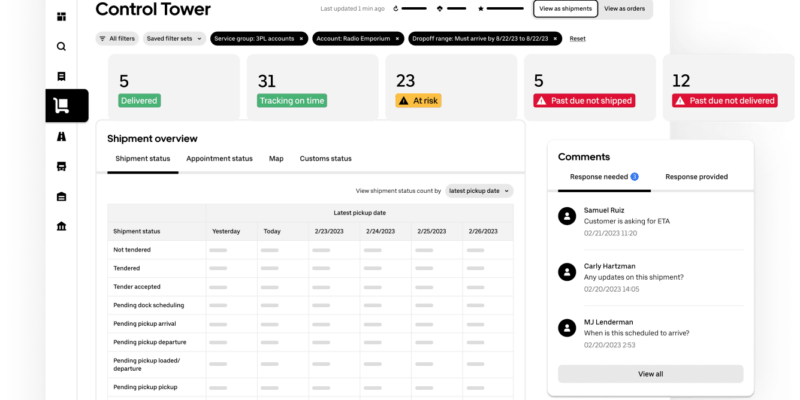Fraud is on the rise: How our team is helping to safeguard the supply chain

Bill McDermott has seen his fair share of fraud in the transportation industry. He spent a decade working as an investigator for FedEx, and then worked complex criminal investigations at the FBI for over 20 years. Now, as Uber Freight’s Senior Investigator and resident expert, he helps ensure shippers are well-protected against financial risk and threats from bad actors.
The growing incidence of fraud in freight today means he’s never been busier.
“Fraud is the worst we’ve ever seen,” McDermott says. In Q2 2023, CargoNet® cited a 57% increase in freight fraud from the same period last year. Other estimates suggest the increase since 2022 could be as high as 400%.
McDermott says that the rapid digitization of logistics operations during the pandemic is a major factor in this increase, because it created vulnerabilities across the supply chain. In addition, bad actors now impersonate carriers in ways that can be difficult to identify. Beyond just spoofed email addresses, they fabricate contracts and rate confirmations with sophisticated levels of forgery.
“It’s a more calculated, organized approach to fraud,” he says.
If left unchecked, fraud can create mass delays, miscommunication, and customer dissatisfaction. It can erode the confidence that shippers and their customers have in logistics processes. Businesses need to incorporate safeguarding measures into their operations to protect themselves. Beyond that, McDermott says, we need industry-wide changes to safeguard everyone in the supply chain—and he and the rest of his team at Uber Freight are leading the charge.
The rise of double-brokering
Just a few weeks ago, McDermott and his team received an urgent call: An account manager had received several suspicious emails from individual(s) alleging to be carriers. They were inquiring about a specific load that had been posted to a load board. The perpetrator created fake company names, logos, and web addresses that were familiar enough to trick the operator into tendering a shipment. Following the tips learned from internal training, the account manager recognized the red flags and did not tender the load to the fake carrier.
This is an example of double-brokering, one of the more common fraud schemes seen by McDermott and his coworkers. It’s a prohibited deception tactic where an individual accepts a load from a broker and posts the load on a public load board, assigning the load to an unwitting carrier. An individual can double their commissions from tendering a single shipment, while unethical carriers benefit by stealing the cargo and receiving a double payment from the shipper and the broker. These bad actors may even try to cover their tracks by re-tendering on load boards and redirecting other carriers to pick up the same shipment at a different location.
According to estimates, between $500 and $700 million of payments are lost to double-brokering each year.
As freight crime evolves with the digital age, criminals overwhelmingly use online platforms like email to carry out double-brokering schemes and employ social engineering tactics to impersonate credible brokers and carriers.
“Double-brokering thrives on deception, and today’s fraudsters are adept at exploiting the digital realm,” McDermott explains. “Transportation leaders need to account for these emerging risks and adapt their practices accordingly.”
Taking action against a surge in freight crime
Rapid decision-making is a requirement for anyone working in the logistics industry. But no one should have to compromise security for the sake of speed.
“It’s not necessarily feasible to do it on every single load, but there are going to be times where a curveball comes in,” McDermott says. “Giving the reps the ability to take the time to verify that shipment would be big.”
The right digital tools are critical. Real-time tracking capabilities can help spot suspicious activity as it’s in progress, and even recover stolen trailers. Automation can help verify carriers using unique identifying information.
But in addition to the steps that individual businesses must take to protect themselves from fraud, there are larger, industry-wide initiatives that will be critical to truly mitigating this growing challenge. McDermott and team are actively working with partners to protect shippers and carriers in the Uber Freight network and beyond. Information-sharing has helped to identify areas where truck break-ins are occurring and alert carriers to avoid stopping until they’re outside a certain range. Building relationships with public load boards has allowed McDermott and team to monitor for fraudulent actors posting duplicate lanes. Even McDermott’s relationship with law enforcement has come in handy—recently, his team helped recover 36 pallets worth of product for a shipper after it was found by the LAPD.
“That’s one of the things that in the Bureau we stressed a lot,” he says. “I was always a member of multi-agency task forces where it was that one team, one fight, mentality. We’re all fighting the same battle. And that’s what I brought over here [to Uber Freight]—making new relationships with the community to better address this threat.”
At its core, the logistics industry relies on a web of trust between shippers, carriers, brokers and customers. As increasingly sophisticated threats jeopardize shipments, businesses will need to implement the right tools to establish further transparency, communication, and automation to maintain that trust and protect the supply chain.
It’s time to fraud-proof your business. Learn key strategies from McDermott and our fraud prevention team in our on-demand webinar.



